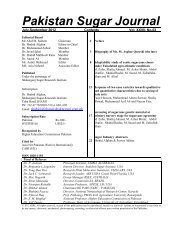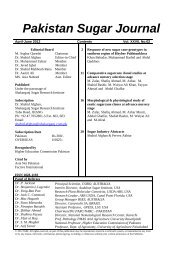Pakistan Sugar Journal
April-June 2010 - Shakarganj Group
April-June 2010 - Shakarganj Group
You also want an ePaper? Increase the reach of your titles
YUMPU automatically turns print PDFs into web optimized ePapers that Google loves.
ate and, an early ability to be colonized by the natural sugarcane endophytic<br />
Gluconocetobocter diozotrophicus.<br />
Gamma Irradiation of embryogenic callus cultures and in vitro selection for salt<br />
tolerance in sugarcane (Sacchorum offfcinarum L.)<br />
Vikas Y Patade, P Suprasanna, and VA Bapata<br />
Radiation induced mutagenesis followed by in vitro selection was employed for salt tolerance<br />
in popular Indian sugarcane (Sacchorum officinarum L.) cv. CoC-671. Embryogenic calli<br />
were gamma irradiated and exposed to different levels of NaCI (42.8,85.6, 128.3, 171.1,<br />
213.9, 256.7, 299.5, or 342.2 mM). The relative growth rate (RGR) decreased progressively<br />
with increasing salt stress and was the least with a salt stress of 256.7 mM (0.25 ± 0.009),<br />
almost 10 fold lesser than the control. The RGR was significantly lower in 85.6 mM and<br />
higher salt stressed calli than the control. The survival percent also decreased, with an<br />
increase in NaCI concentration. In case of 10 and 20 Gy irradiated calli, regeneration was<br />
observed up to 85.6 mM NaCI selection, medium, whereas, higher treatments (128.3 mM and<br />
beyond) exhibited browning initially. However, in the subsequent subcultures, regeneration<br />
was obtained in the case of 10 and 20 Gy irradiated calli on 128.3 and 171.1 mM NaCI<br />
selections. Higher dose of gamma irradiation (40 Gy) also showed regeneration, but only<br />
with 85.6 mM NaCI selection. The unirradiated calli regenerated the highest number of<br />
plantlets followed by 10 and 20 Gy irradiated calli on salt selection. A total of 147 plantlets<br />
were selected from different salt levels. The salt selected plants are being tested for their field<br />
performance.<br />
Effect of exogenous arginine on sugarcane (Saccharum sp.) somatic embryogenesis, free<br />
polyamines and the contents of the soluble proteins and proline<br />
N. Nieves, F. Sagarra, R. Gonzalez, Y. Lezcano, M. Cid, M. A. Blanco and R. Castillo<br />
The aim of this study was to evaluate the effect of arginine on sugarcane (Saccharum sp.)<br />
somatic embryogenesis, free polyamines and other nitrogenous compounds contents.<br />
Segments of leaves were used as explants to establish embryo-genie cultures on media with 0<br />
and 50.0 mg I" I arginine. Somatic embryos formation and free polyamines, free proline and<br />
total soluble proteins contents were compared. Arginine significantly induced sugarcane<br />
somatic embryogenesis. Free proline and protein levels determined in embryogenic cell<br />
masses during embryo differentiation-maturation, showed an arginine-induced promotion<br />
associated to the enhancement of the embryogenic process. In addition, free putrescine and,<br />
in a minor extent, spermidine and spermine contents were enhanced by arginine.<br />
Regulation of photosynthesis by sugars in sugarcane leaves<br />
Alistair James McCormick, Michael D. Cramer, and Derek A. Watt<br />
In sugarcane, increased sink demand has previously been shown to result in increased<br />
photosynthetic rates that are correlated with a reduction in leaf hexose concentrations. To<br />
establish whether sink limitation of photosynthesis is a result of sugar accumulation in the<br />
leaf, excision and cold-girdling techniques were used to modify leaf sugar concentrations in<br />
pot-grown sugarcane In excised leaves that were preincubated in darkness for 3h, sucrose<br />
accumulation was reduced but accumulated again upon transfer to the light, while hexose<br />
concentrations remained lower than in controls (7.7 |omol mg' 1 FW versus 18.6 ^mol mgol<br />
mg -1 FW versus 18.6 fimol mg -1 FW hexose in controls). These results were associated with a






